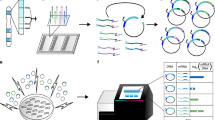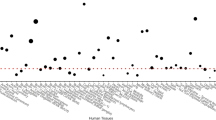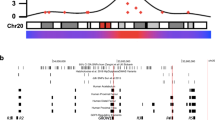Abstract
Osteoarthritis (MIM 165720), characterized by degeneration of articular cartilage, is the most common form of human arthritis and a major concern for aging societies worldwide1,2,3. Epidemiological and genetic studies have shown that osteoarthritis is a polygenic disease1,4,5. Here, we report that the gene encoding growth differentiation factor 5 (GDF5) is associated with osteoarthritis in Asian populations. A SNP in the 5′ UTR of GDF5 (+104T/C; rs143383) showed significant association (P = 1.8 × 10−13) with hip osteoarthritis in two independent Japanese populations. This association was replicated for knee osteoarthritis in Japanese (P = 0.0021) and Han Chinese (P = 0.00028) populations. This SNP, located in the GDF5 core promoter, exerts allelic differences on transcriptional activity in chondrogenic cells, with the susceptibility allele showing reduced activity. Our findings implicate GDF5 as a susceptibility gene for osteoarthritis and suggest that decreased GDF5 expression is involved in the pathogenesis of osteoarthritis.
This is a preview of subscription content, access via your institution
Access options
Subscribe to this journal
Receive 12 print issues and online access
$209.00 per year
only $17.42 per issue
Buy this article
- Purchase on Springer Link
- Instant access to full article PDF
Prices may be subject to local taxes which are calculated during checkout


Similar content being viewed by others
Accession codes
References
Kellgren, J.H. & Moore, R. Generalized osteoarthritis and Heberden's nodes. Br. Med. J. 1, 181–187 (1952).
Oliveria, S.A., Felson, D.T., Reed, J.I., Cirillo, P.A. & Walker, A.M. Incidence of symptomatic hand, hip, and knee osteoarthritis among patients in a health maintenance organization. Arthritis Rheum. 38, 1134–1141 (1995).
Felson, D.T. & Zhang, Y. An update on the epidemiology of knee and hip osteoarthritis with a view to prevention. Arthritis Rheum. 41, 1343–1355 (1998).
Stecher, R.M. Heberden's nodes: heredity in hypertrophic arthritis of the finger joints. Am. J. Med. Sci. 201, 801–809 (1941).
Kellgren, J.H., Lawrence, J.S. & Bier, F. Genetic factors in generalized osteo-arthrosis. Ann. Rheum. Dis. 22, 237–255 (1963).
Francis-West, P.H. et al. Mechanisms of GDF-5 action during skeletal development. Development 126, 1305–1315 (1999).
Merino, R. et al. Expression and function of Gdf-5 during digit skeletogenesis in the embryonic chick leg bud. Dev. Biol. 206, 33–45 (1999).
Storm, E.E. et al. Limb alterations in brachypodism mice due to mutations in a new member of the TGFβ-superfamily. Nature 368, 639–643 (1994).
Thomas, J.T. et al. A human chondrodysplasia due to a mutation in a TGF-β superfamily member. Nat. Genet. 12, 315–317 (1996).
Erlacher, L. et al. Cartilage-derived morphogenetic proteins and osteogenic protein-1 differentially regulate osteogenesis. J. Bone Miner. Res. 13, 383–392 (1998).
Wolfman, N.M. et al. Ectopic induction of tendon and ligament in rats by growth and differentiation factors 5, 6, and 7, members of the TGF-β gene family. J. Clin. Invest. 100, 321–330 (1997).
Tsumaki, N. et al. Role of CDMP-1 in skeletal morphogenesis: promotion of mesenchymal cell recruitment and chondrocyte differentiation. J. Cell Biol. 144, 161–173 (1999).
Faiyaz-Ul-Haque, M. et al. Frameshift mutation in the cartilage-derived morphogenetic protein 1 (CDMP1) gene and severe acromesomelic chondrodysplasia resembling Grebe-type chondrodysplasia. Am. J. Med. Genet. 111, 31–37 (2002).
Savarirayan, R. et al. Broad phenotypic spectrum caused by an identical heterozygous CDMP-1 mutation in three unrelated families. Am. J. Med. Genet. A 117, 136–142 (2003).
Sugiura, T., Hotten, G. & Kawai, S. Minimal promoter components of the human growth/differentiation factor-5 gene. Biochem. Biophys. Res. Commun. 263, 707–713 (1999).
Freedman, M.L. et al. Assessing the impact of population stratification on genetic association studies. Nat. Genet. 36, 388–393 (2004).
Chang, S.C. et al. Cartilage-derived morphogenetic proteins. New members of the transforming growth factor-beta superfamily predominantly expressed in long bones during human embryonic development. J. Biol. Chem. 269, 28227–28234 (1994).
Storm, E.E. & Kingsley, D.M. GDF5 coordinates bone and joint formation during digit development. Dev. Biol. 209, 11–27 (1999).
Hotten, G.C. et al. Recombinant human growth/differentiation factor 5 stimulates mesenchyme aggregation and chondrogenesis responsible for the skeletal development of limbs. Growth Factors 13, 65–74 (1996).
Bobacz, K. et al. Cartilage-derived morphogenetic protein-1 and -2 are endogenously expressed in healthy and osteoarthritic human articular chondrocytes and stimulate matrix synthesis. Osteoarthritis Cartilage 10, 394–401 (2002).
Kizawa, H. et al. An aspartic acid repeat polymorphism in asporin inhibits chondrogenesis and increases susceptibility to osteoarthritis. Nat. Genet. 37, 138–144 (2005).
Mabuchi, A. et al. Identification of sequence polymorphisms of the COMP (cartilage oligomeric matrix protein) gene and association study in osteoarthrosis of the knee and hip joints. J. Hum. Genet. 46, 456–462 (2001).
Mototani, H. et al. A functional single nucleotide polymorphism in the core promoter region of CALM1 is associated with hip osteoarthritis in Japanese. Hum. Mol. Genet. 14, 1009–1017 (2005).
Ikeda, T. et al. Identification of sequence polymorphisms in two sulfation-related genes, PAPSS2 and SLC26A2, and an association analysis with knee osteoarthritis. J. Hum. Genet. 46, 538–543 (2001).
Jiang, Q. et al. Replication of the association of the aspartic acid repeat polymorphism in the asporin gene with knee-osteoarthritis susceptibility in Han Chinese. J. Hum. Genet. 51, 1068–1072 (2006).
Ohnishi, Y. et al. A high-throughput SNP typing system for genome-wide association studies. J. Hum. Genet. 46, 471–477 (2001).
Kunisada, T. et al. A new human chondrosarcoma cell line (OUMS-27) that maintains chondrocytic differentiation. Int. J. Cancer 77, 854–859 (1998).
Takigawa, M. et al. Establishment of a clonal human chondrosarcoma cell line with cartilage phenotypes. Cancer Res. 49, 3996–4002 (1989).
Chano, T. et al. Characterization of a newly established human chondrosarcoma cell line, CS-OKB. Virchows Arch. 432, 529–534 (1998).
Ott, J. Counting methods (EM algorithm) in human pedigree analysis: linkage and segregation analysis. Ann. Hum. Genet. 40, 443–454 (1977).
Acknowledgements
We thank individuals for participating the study. We also thank K. Toyoshima, A. Kotani, K. Nakamura, A. Fukuda, A. Kawakami, H. Mototani and E. Nakashima for help in collecting samples and performing the experimental study and Y. Takanashi and T. Kusadokoro for technical assistance.
Author information
Authors and Affiliations
Contributions
Y.M. performed the Japanese knee osteoarthritis association study and prepared the manuscript. A.M. performed the hip association study, in vitro functional assay and prepared the manuscript. D.S. performed the Chinese association study. T.K., Y.T., S.S., M.F., A.S., A.U., S.Y., K.O. and Y.N. managed DNA sample and clinical information, and contributed data interpretation. K.O. and M.T. contributed to cell experiments. T.T. contributed to data analysis and manuscript preparation. Q.J. managed the Chinese association study. S.I. planned and supervised the whole project.
Corresponding author
Ethics declarations
Competing interests
The authors declare no competing financial interests.
Supplementary information
Supplementary Fig. 1
Confirmation of the allelic difference of rs143383 (+104C/T) in OUMS-27 and HeLa cells (PDF 73 kb)
Supplementary Table 1
Initial association of GDF5 with osteoarthritis of the hip joint (PDF 20 kb)
Supplementary Table 2
Replication of association of GDF5 with osteoarthritis of the hip joint in an independent population (PDF 20 kb)
Supplementary Table 3
List of polymorphisms in GDF5 and flanking regions (PDF 24 kb)
Supplementary Table 4
Clinical parameters and and the genotype of rs143383 (+104T/C) (PDF 19 kb)
Supplementary Table 5
Association of rs143383 with osteoarthritis after stratification by sex (PDF 95 kb)
Supplementary Table 6
Assessment of the population stratification (PDF 25 kb)
Supplementary Table 7
Haplotype association analysis (PDF 17 kb)
Supplementary Table 8
Clinical parameters (PDF 44 kb)
Rights and permissions
About this article
Cite this article
Miyamoto, Y., Mabuchi, A., Shi, D. et al. A functional polymorphism in the 5′ UTR of GDF5 is associated with susceptibility to osteoarthritis. Nat Genet 39, 529–533 (2007). https://doi.org/10.1038/2005
Received:
Accepted:
Published:
Issue Date:
DOI: https://doi.org/10.1038/2005
This article is cited by
-
Identification of candidate genes and chemicals associated with osteoarthritis by transcriptome-wide association study and chemical-gene interaction analysis
Arthritis Research & Therapy (2023)
-
The association of growth differentiation factor 5 rs143383 gene polymorphism with osteoarthritis: a systematic review and meta-analysis
Journal of Orthopaedic Surgery and Research (2023)
-
HOXA10 promotes Gdf5 expression in articular chondrocytes
Scientific Reports (2023)
-
Associations between adipokines gene polymorphisms and knee osteoarthritis: a meta-analysis
BMC Musculoskeletal Disorders (2022)
-
Identification of candidate enhancers controlling the transcriptome during the formation of interphalangeal joints
Scientific Reports (2022)



